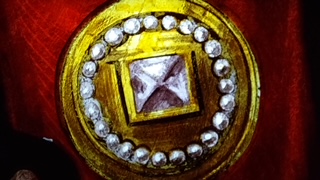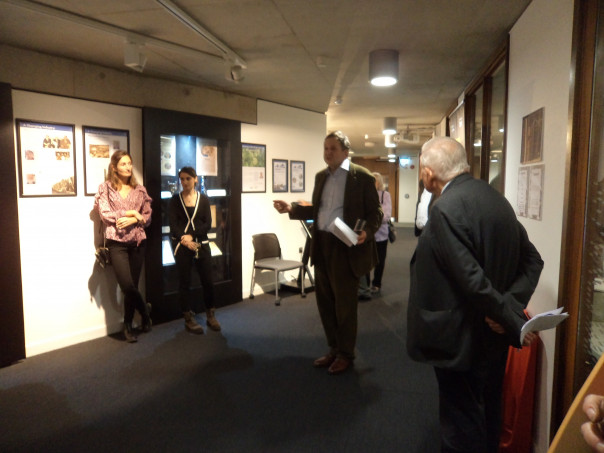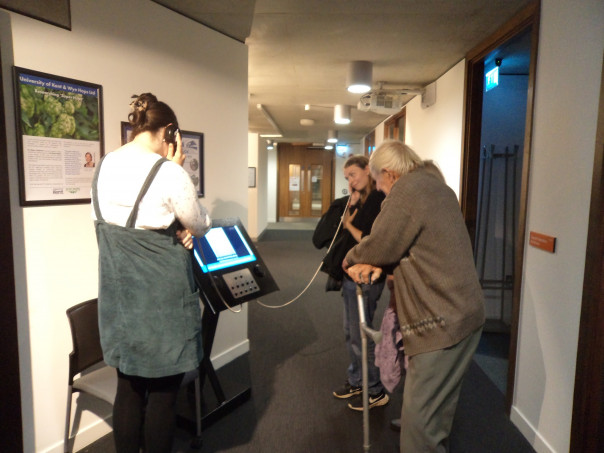This is yet again a busy week for staff and postgraduates associated with CKHH – as well as Kent, I’ll be in Yorkshire and Somerset, which means paradoxically I’m intending to keep this as a shortish blog. Consequently, I’m very grateful to Kieron Hoyle for her short piece with Martin Crowther’s photos on how the restoration project at Dover’s Maison Dieu is progressing, but before that I have some news from Monday.
It gives me great pleasure to report that Tracey Dessoy passed her doctorate on Monday with minor corrections. As with Janet Clayton last academic year that’s excellent and that means another doctoral thesis on an aspect of Kent’s medieval history, in Tracey’s case on medieval women in Canterbury and its hinterland in the High Middle Ages concerning their piety, patronage and agency. So congratulations Tracey!

Now to Kieron’s report: “This week, I had the opportunity to visit the Maison Dieu in Dover with Martin Crowther to see the latest developments in the ongoing £10.5 million restoration project. The conservation efforts have significantly enhanced the site’s historical and architectural features. The scaffolding in the Stone Hall has now been removed and the newly conserved and clean stained glass windows depicting significant events in the history of Dover are once again visible. This means Edward Poynter’s windows including King Henry VIII’s departure for the Field of the Cloth of Gold in May 1520 and the landing of Charles II during his restoration in May 1660 have come alive again and the tiniest details have been revealed from the splendour of Henry VIIIs jewels to the costumes of his courtiers.
The most remarkable transformation is observed in Connaught Hall, where the ceiling has undergone extensive conservation. Stripped of the pale blue paint, the original design by William Burges has been conserved and replicated using stencils and hand-painted panels, resulting in a breath-taking palette of colours including Wyvern dragons that now enhance the hall’s visual splendour.

Other areas that have been conserved and repaired are the Victorian cells which are still labelled for felons, debtors or vagrants. The medieval stone staircase once again leads to small upper chambers and the internal courtyards are repaired and once the scaffolding is removed will enhance the building further.
I have been studying this building for just over two years and it is wonderful to see its transformation. The Maison Dieu has been adapted to the needs of Dover since its foundation, from pilgrims’ hospital to a naval victualling yard, court room, jail and council chamber and hopefully it will be as successful in its new life providing for the local community. The plan is for the Maison Dieu to reopen to the public in 2025.”

My second report concerns the ‘Local Stories: Memories of Hopping around Brook and Wye, Kent’ exhibition at the Templeman Library, University of Kent, which was officially opened last Friday and which Jason Mazzocchi and I attended. Also at the opening was Dr John Bulaitis, who like me is a trustee of the Brook Rural Museum, and I expect that you will remember that about a month ago he gave the Michael Nightingale Memorial Lecture as a joint CKHH/Brook Rural Museum event: https://blogs.canterbury.ac.uk/kenthistory/the-tithe-war-kent-and-england/

It is worth pointing out that even though today very few hop fields survive in Kent, John Hills as part of CCCU’s Sustainability team regularly grows of hops on the university’s campus, to be used by the local microbrewery at The Foundary in Canterbury. However, to return to this free exhibition, which will run until the 29 November, the person behind this oral history project is Dr Philippa Mesiano, Community Engagement and Project Manager at the Museum, who was helped by a keen group of volunteers. Among those interviewed were former trustees and others from the farming community in the Brook and Wye area, including former staff members at the University of London’s Wye Agricultural College. Consequently, once all had had a chance to have a brief look at the exhibition, Professor John Nightingale, as chairman of the Museum trustees, welcomed everyone and in his opening remarks congratulated and thanked Philippa and others involved in setting up the various displays, both information panels and various objects from the Museum’s collection, as well as pointing out the innovative use of oral short pieces that people can listen to.

He then handed over to Sir John Mummery, another trustee, to say a few words before formally opening the exhibition. Sir John’s speech was fascinating because, as he pointed out, his family can be seen as early modern ‘boat people’ because they were religious refugees fleeing from continental Europe to start a new life in Protestant England. Having arrived in Kent, the family settled here as farmers and some family members still follow the same occupation today. Thus, Sir John grew up on a mixed farm, and even though his father did not grow hops, he was aware of such farms in the neighbourhood. This meant he was also aware of the people who came down, frequently from London, to work picking hops, their experiences very different from the rosy publicity produced at the time because it was long hours, very hard work, often in poor living conditions, and the amenities promised were part of an adman’s dream. Sir John also noted that the part of east Kent where his family were living was close to some of Kent’s coalfields, another industry that has yet to receive the attention it deserves from historians and its history is generally not known by the public. For while this drew in miners from other parts of the British Isles, leading to what might be termed a ‘new’ east Kent accent, the working conditions were extremely hard. To a degree, this story is now being told at the new Kent Mining Museum: https://www.kentminingmuseum.co.uk/ but it would be good if this could be explored in other ways too.

For Sir John growing up on the family farm, one of the things he was determined not to be was a farmer and having read History at university following his time at grammar school, he very successfully turned to the law as a career. Yet he never lost his family’s roots in these land-based industries and, while his brothers are farmers, he has been actively involved as an enthusiastic trustee at Brook for a long time. Moreover, being able to bring his judicial expertise to the table on the Museum’s behalf has been extremely valuable. In his final remarks, he encouraged people to listen to the interview clips and to provide feedback, which is required by almost all funding bodies these days in relation to the visitor experience and what they have gained from looking and listening.
This was very well received and having again thanked and congratulated Philippa, the considerable audience of trustees, volunteers, Brook Museum staff, university library staff, some members of the public and some students returned to exploring the exhibition and leaving their responses, either using the QR code or post it notes on the board.
Finally, for next week I am hoping to bring items from Wells and Cambridge if it all goes to plan!
 Centre for Kent History and Heritage
Centre for Kent History and Heritage Sheila Sweetinburgh
Sheila Sweetinburgh 2204
2204


Huge congratulations to Dr Tracey Dessoy!